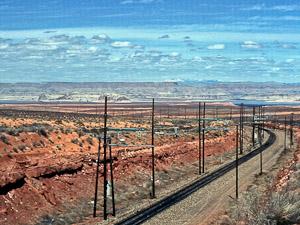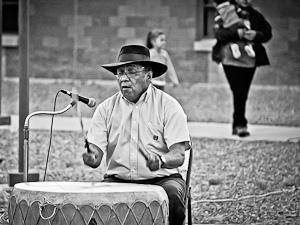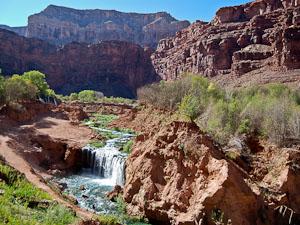
Legal battles among Hopi, Navajo, government and private organizations over fragile natural resources now threaten to completely destroy the traditions of many people still living on the land near Black Mesa. After strip mining contaminated ground water and increased health risks, many Navajo were forced from the homes their families had lived in for generations.

About a thousand Navajo chose to stay in their homes on the HPL, despite the threat of forcible ejection by the deadline in 1986. The Bureau of Indian Affairs had considered sending in armed agents and federal marshals, but the threat of a PR spectacle – seventy-year-old grandmothers facing off against the U.S. government – made them back down. But the impoundments and other oppressions did not stop, wearing at the remaining Navajo who just wanted to live in peace on the land they loved.
In 1996, Congress again injected federal legislation into the fray by passing an amended version of the 1974 Navajo-Hopi Land Settlement Act. If they physically signed this document, the Navajo remaining on the HPL would be granted a seventy-five-year lease on three-acre homesites and the right to graze and pray – provided they got a permit for both from the Hopi. Those who did not sign were to be forcibly ejected. The land could not be passed on: once the signer died, the lease was broken. To sweeten the deal, the Settlement Act authorized millions of dollars to be paid to both the Hopi Tribe and the Navajo Nation, with the stipulation that 85 percent of the residents must sign in order to receive the funds. The Navajo on the HPL were told by their Tribal Council that the funds would provide them with better housing and infrastructure and would otherwise provide for their needs. Most of them signed; only twenty-six people, including Katherine Smith, refused. The elders cannot read or write; to sign, they laid down an ink thumbprint.
Instead of using the money to benefit the people still living on the HPL, the Navajo Tribal Council put it into an undesignated reserve trust and has been using it for projects on other parts of the reservation. The Tribal Council does nothing to help the elders of Black Mesa, who live without electricity or running water; whose roads are in terrible shape, who have livestock quotas enforced, and who are still subjected to constant survey and harassment by Hopi Rangers. For them, not much has changed.

Although a few Hopi traditional elders were against mining at Black Mesa and did not want the Navajo to be removed from their homes, their voices are lower now, not heard among their own tribe. A delegation of Hopi and Navajo elders joined together in 2001, bought two shares of stock and attended a stockholders meeting of Lehman Brothers after it acquired a large financial interest in Peabody. They warned that there would be dire spiritual consequences from the mining of their sacred Black Mesa. Eight years later, Lehman Brothers went bankrupt. Out on one of the Hopi mesas are their own prophecy stones, carved with apocalyptic messages for generations to come. An interpretation of one set of symbols foretells of a time when the Hopi will be seduced by greed. When the HPL is finally vacant of the Navajo, among the plans the tribe is contemplating for the area is a paved highway, a huge hotel complex and a casino.
The Hopi Rangers showed up at Katherine Smith's, demanding that the volunteers leave because they did not have a permit to camp. A frantic call was made to Tim, another tribe member who helps out members of the community. He left his son's basketball game, went to the Hopi Police and negotiated a permit. Tim is the seventh son of a powerful Navajo medicine man; his own powerful knowledge of the law, the explicit terms of the Settlement Act and the call of humanity speak through his soft voice. He convinced the Hopi that the Caravan was here to help the elders, not participate in politics. The volunteers did have to move, cluster into a small field closer to the hogans, but were allowed to stay.

Tim acknowledges that there is probably no way the Navajo can continue to live on the Hopi partition lands, not his children or grandchildren. Some of the relocated Navajo have tried to come back to their homes, or younger family members move in with their elders, but the Hopi are keeping close track. They are waiting for the elders to die, for the seventy-five-year lease to expire. The resonance of oppression is deep in the elders, and the imprint of the historical trauma they have experienced. Yet their resilience is inspirational. Many of the elders who spoke at the opening ceremony were incensed over the recent Navajo-San Juan River Water Settlement. Though this was touted by their Tribal Council and the press as a landmark water-rights milestone for the Navajo, the elders felt it was one more example of treating their natural resources as a national sacrifice area, where much is taken, leaving little for future generations.
"We're still here," Tim said. "We could have given up. We still have our language, ways of teaching, our medicines, our families, our prayers. Once the Navajo culture dies out, it's gone."
As I drove away from the reservation lands, I remembered what Tim shared with me about the Dine prayers that sing the self together, with the community and the land. They sing to the four directions: the South is faith; the West is charity; the North is love. The East, where the sun rises, hope.
Photos are copyright protected and may not be reproduced without permission. Copyright information for images is as follows: 1) Black Mesa Railroad, photo courtesy of David Wilson and used with the permission of Flickr Creative Commons Attribution License 2.0 Generic; 2) Rhythmic Passion, photo courtesy of Donovan Shortey and used with the permission of Flickr Creative Commons Attribution License 2.0 Generic; 3) Rock Falls, photo courtesy of Kingdafy and used with the permission of Flickr Creative Commons Attribution License 2.0 Generic.